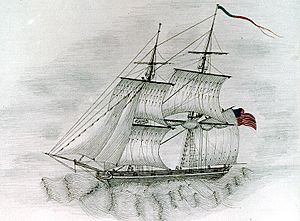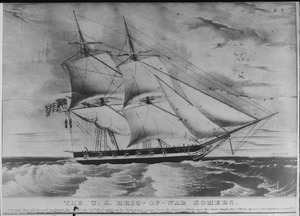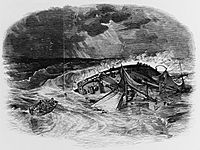USS Somers (1842) facts for kids

USS Somers
|
|
Quick facts for kids History |
|
|---|---|
| Name | USS Somers |
| Launched | 16 April 1842 |
| Commissioned | 12 May 1842 |
| Fate | Sank, 8 December 1846 |
| General characteristics | |
| Displacement | 259 long tons (263 t) |
| Length | 100 ft (30 m) |
| Beam | 25 ft (7.6 m) |
| Draft | 14 ft (4.3 m) |
| Propulsion | Sail |
| Complement | 13 officers and 180 men |
| Armament | 10 × 32 pdr (15 kg) carronades |
The USS Somers was a small, fast sailing ship called a brig. It served in the United States Navy when John Tyler was president. This ship became famous for a very sad reason. It was the only U.S. Navy ship where a mutiny (a rebellion by the crew) happened that led to people being put to death.
The Somers was built at the New York Navy Yard. It was launched on April 16, 1842. The ship officially started service on May 12, 1842. Commander Alexander Slidell Mackenzie was its first captain.
Contents
First Journey of the USS Somers
In June and July, the Somers went on a short trip to Puerto Rico. This was a "shakedown cruise" to test the new ship and its crew. After this, the brig left New York on September 13, 1842. It was heading to the Atlantic coast of Africa.
The ship was carrying important messages for another Navy ship, the Vandalia. The Somers was also being used as a special training ship. Young sailors, called naval apprentices, learned their skills on board. The Somers visited places like Madeira and Tenerife. It was looking for the Vandalia.
On November 10, the Somers arrived in Monrovia, Liberia. There, they found out the Vandalia had already left for home. The next day, Commander Mackenzie decided to sail to the Virgin Islands. He hoped to meet the Vandalia at St. Thomas. Then, the Somers would return to New York.
The Somers Mutiny Incident
On November 25, 1842, while sailing to the West Indies, something serious happened. A young officer, Midshipman Philip Spencer, was on board. Spencer was the son of Secretary of War John C. Spencer. He reportedly told a ship's worker, J.W. Wales, about a plan.
Spencer claimed about 20 crew members planned a mutiny. They wanted to take over the ship. Their goal was to use the Somers for piracy near the Isle of Pines. Another sailor, Seaman Elisha Small, was part of this talk. Wales was warned that he would be killed if he told anyone.
Reporting the Suspicions
On November 26, Wales told Captain Mackenzie about the plan. He did this through his officers. Captain Mackenzie did not take it seriously at first. But he told Lieutenant Gansevoort to watch Spencer and the crew. Lieutenant Gansevoort learned more from other crew members. They said Spencer had secret meetings at night. He met with Seaman Small and Boatswain's Mate Samuel Cromwell.
That evening, Captain Mackenzie asked Spencer about Wales's story. Spencer said it was just a joke. But he was arrested and put in chains on the ship's deck. Officers searched Spencer's locker. They found papers written in Greek. Another midshipman, Henry Rodgers, translated them.
The Secret Papers
The translated papers listed names under different categories:
- CERTAIN: P. Spencer, E. Andrews, D. McKinley, Wales
- DOUBTFUL: Wilson (X), McKee (X), Warner, Green, Gedney, Van Veltzor, Sullivan, Godfrey, Gallia (X), Howard (X)
- The (X) names would likely join before the plan started.
- Others would join later or be forced.
- NOLENS VOLENS (meaning "willing or unwilling"): Sibley, Van Brunt, Blackwell, Clarke, Corney, Garratrantz, Strummond, Witmore, Waltham, Nevilles, Dickinson, Riley, Scott, Crawley, Rodman, Selsor, The Doctor.
The papers also listed who would be in charge of different parts of the ship. This included the wheel, cabin, and armory.
More Suspicions and Arrests
On November 27, a mast on the ship broke. This damaged some of the sails. The time and way it happened seemed suspicious. Cromwell, who was the biggest man on the crew, was asked about his meetings with Spencer. Cromwell said, "It was not me, sir – it was Small." Small was then questioned. He admitted meeting with Spencer. Both Cromwell and Small were arrested. They joined Spencer in chains on the deck.
On November 28, a ship's worker named Henry Waltham was punished. He had stolen brandy for Spencer. After this, Captain Mackenzie told the crew about Spencer's plot. He said Spencer planned to have them killed. Waltham was punished again on November 29. He had suggested stealing wine to another apprentice. That afternoon, Charles A. Wilson, a sailmaker's helper, tried to get a weapon. Also, Landsman McKinley and Apprentice Green missed their midnight duty call.
On November 30, four more men were arrested. These were Wilson, McKinley, Green, and Alexander McKie, who was Cromwell's friend. Captain Mackenzie then asked his seven senior officers for their advice. He wanted to know what they thought was the best thing to do. The officers met and interviewed many crew members.
The Officers' Decision
On December 1, the officers gave their decision. They all agreed that Spencer, Cromwell, and Small were "guilty of a full and determined intention to commit a mutiny." They recommended that the three men be put to death. Spencer had claimed they were just "pretending piracy."
The three men were hanged that day. Their bodies were buried at sea. Some people later wondered if the captain should have waited. The ship was only thirteen days from home. But the captain said his officers were tired. He also noted the ship was small, and it was hard to keep the prisoners safely confined.
The Somers arrived at St. Thomas on December 5. It returned to New York on December 14. A naval court investigated the mutiny and the executions. This court said Captain Mackenzie was not guilty. He also asked for a special military trial, called a court-martial. This trial also cleared him. However, many people outside the Navy still doubted his actions.
Serving in the Home Squadron
On March 20, 1843, Lieutenant John West took command of the Somers. The brig was then assigned to the Home Squadron. For the next few years, the Somers served along the Atlantic coast. It also sailed in the West Indies.
The Mexican–American War
In the spring of 1846, the Somers was in the Gulf of Mexico. It was near Veracruz when the Mexican–American War began. The ship stayed in that area, blocking the port. It only left to get supplies from Pensacola, Florida.
The Criolla Incident
On November 26, the Somers was still blocking Veracruz. Lieutenant Raphael Semmes was in command. A Mexican ship, the schooner Criolla, managed to slip into the port. The Somers sent a small boat party. They boarded and captured the Criolla. But there was no wind, so they couldn't sail the captured ship out to sea. So, they set the Criolla on fire. The Americans returned to the Somers while being shot at from shore. They brought back seven prisoners.
Sadly, the Criolla turned out to be a US spy ship. It was working for Commodore David Conner. This was a big misunderstanding.
The Sinking of the Somers
On December 8, 1846, the Somers was chasing another ship. This ship was trying to get past the blockade near Veracruz. Suddenly, a strong, sudden storm hit. The Somers tipped over and sank. Thirty-six of its 80 crew members were lost. Eight survivors were saved by a British ship, HMS Endymion. Eight more swam to shore but were captured. Other survivors were rescued by English and French ships. On March 3, 1847, the U.S. Congress gave special medals. These were for the officers and men of the French, British, and Spanish ships who helped with the rescue.
Legacy and Discovery of the Wreck
The events on the Somers had a lasting impact. The famous writer Herman Melville was influenced by the mutiny. His cousin, Lieutenant Guert Gansevoort, was an officer on the Somers during the incident. Melville may have used parts of this story in his book Billy Budd.
The Somers Affair is also described in books like Voyage to the First of December and The Big Family. It was even shown in an episode of the TV show JAG.
Finding the Wreck
In 1986, an explorer named George Belcher found the wreck of the Somers. In 1987, archaeologists James Delgado and Mitchell Marken confirmed it was the Somers. In 1990, Delgado worked with Pilar Luna Erreguerena. They led a joint team of archaeologists and divers from Mexico and the U.S. They found that someone had taken things from the wreck after 1987. The wreck is now a protected site.
The most important legacy of the Somers Affair is the creation of the United States Naval Academy. Naval leaders were very concerned that a young officer would plan a mutiny. They decided that officers needed better training. So, they ordered the creation of the academy. This way, young officers could get a proper education. They would learn about naval skills and other important subjects in a supervised place.
See also
 In Spanish: USS Somers (1842) para niños
In Spanish: USS Somers (1842) para niños



